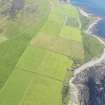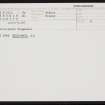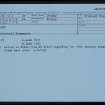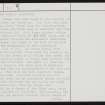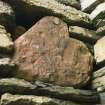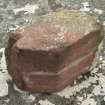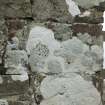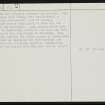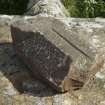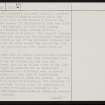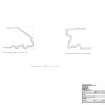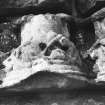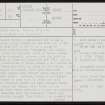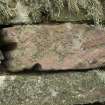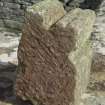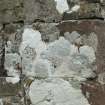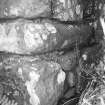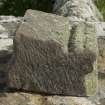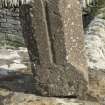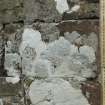Rousay, Westside, The Wirk
Architectural Fragment (13th Century), Architectural Fragment(S) (Period Unknown), Architectural Fragment (16th Century)
Site Name Rousay, Westside, The Wirk
Classification Architectural Fragment (13th Century), Architectural Fragment(S) (Period Unknown), Architectural Fragment (16th Century)
Canmore ID 2283
Site Number HY33SE 17.01
NGR HY 3738 3019
NGR Description From HY 3738 3019 to HY 4285 2777
Datum OSGB36 - NGR
Permalink http://canmore.org.uk/site/2283
- Council Orkney Islands
- Parish Rousay And Egilsay
- Former Region Orkney Islands Area
- Former District Orkney
- Former County Orkney
HY33SE 17.01 3738 3019 to 4285 2777
Linking the monastic church on Eynhallow [HY32NE 2] with the old Rousay parish church at Westside [HY33SE 16] and with The Wirk [HY33SE 17.00] is a group of elaborately carved architectural fragments, the origin and history of which are unknown. Most of these stones are built up as an ornamental gateway over the path to the kitchen-garden at Trumland House [HY 428 277], and so obvious is the resemblance of these pieces - all carved in a red sandstone freestone which is alien to the island - to details of St Magnus Cathedral, that some islanders believe that these stones were brought quite recently from Kirkwall by Walter Grant. Since Grant has a Kirkwall residence as well as Trumland, and allowing that a good many pieces of Cathedral – supplanted by new stonework during renovations over the last hundred years – are to be seen on various Kirkwall rockeries (notably the very splendid one in the public garden behind Tankerness House), this is a reasonable enough assumption. There is, however, sufficient documentary evidence to show that at least the most important of the Trumland stones had been brought there from Westside, while the stones still there and on Eynhallow confirm that these were not a modern acquisition; unfortunately however, one cannot rule out the possibility that the Trumland archway may contain some material brought from Kirkwall to augment the stones which were locally available.
Elaborately-cut stones have been found in the vicinity of The Wirk on at least two occasions. The first was prior to 1870, when Sir Henry Dryden made his investigations, the results of which are drawn upon by MacGibbon and Ross (1896-7, i, 108-9) and by Dietrichson (1906, 108). Both these sources mention stones, then at Westness House [HY 383 289], which made up an arch. The second occasion was Clouston's excavation in 1930, when stones were found at the foot of The Wirk and built into the foundations of the substantial building to the E of it (Clouston 1931). An ornate finial with crocketed gables and sixteen human heads was found by an outside corner of the tower, as if fallen from above, and a 16th-century armorial panel of Bishop Adam Bothwell was found in a similar situation. RCAHMS (1946) reported that the stones, which by the 1930s were at Trumland, had been collected from the neighbourhood of The Wirk and Westside Church. They list the more important pieces, including the pinnacle. Clouston believed that his building E of the tower was an incomplete church and that the stones had been collected for use on it; RCAHMS commented, very reasonably, that the stones were 'appropriate only for a church of the first rank, which can hardly have existed at Westside' (1946, ii, 191, No. 549). The pinnacle, the Bothwell armorial and another armorial are no longer at Trumland; the armorials have been removed to Balfour Castle, Shapinsay, and an unprovenanced pinnacle exactly fitting the descriptions of the Westside one is in Tankerness House Museum.
More stones - including ones which closely match some of those piled loosely on the W terrace of Trumland House - are built into the walls of St Mary's Church (the writer is indebted to Dr Sigrid Kaland who first noticed these) [HY33SE 16]. They are placed no higher than halfway up the walls at the E end; the church was disused after 1815 and it is unlikely that they were inserted after that date. Another group of fragments was found in the debris when Eynhallow church was cleared out; these are still on the island, piled in a heap in a chamber of the monastic buildings. Once again, the pieces are of red freestone, which is not local, and they contrast with the crude stonework of the church which is built of unmortared Rousay flag shaped only by splitting. Even the chancel arch and the W arch of the nave are built of these split slabs; the dressed freestones, by reason of their fine quality and their implication of the use of mortar, find no obvious place in the buildings as they now stand.
What is especially puzzling about these stones is that they are not all of the same period. Some of them date from the 13th century, others from the 16th; there are some which are difficult to date precisely and they may fall between these periods. On Eynhallow most belong to the later period but there is at least one of 13th century date. The pieces originating from Westside include stones from both the 13th and 16th centuries; it will be noted that Clouston’s excavations produced, in close proximity, a 13th century finial and a 16th century armorial.
St Magnus Cathedral is the only known building in Orkney where the 13th-century stones could have looked in place. The Trumland garden-gateway incorporates stones of at least two different arched doorways, one of which has two orders of dogtooth ornament; and prominent also is a massive block carved into four foliaceous capitals which RCAHMS compares with work on the central W door of the Cathedral. These pieces fit stylistically into the first quarter of the 13th century, to which that doorway belongs, but the Trumland stone-carving differs significantly from that at Kirkwall [...]; the general feeling is that the styles are close, but the Trumland stones are not by the same hand as any of the Cathedral details. And the pinnacle, which can be dated nearer the end of the 13th century, is in an extravagently rich style which is alien to Kirkwall.
What then can be made of all this? At some time or times, architectural ornament, carved on stone which matches that used at Kirkwall and in a style which can be related to, but does not precisely duplicate, the styles in use there in the 13th century, was brought to Westside and to Eynhallow. Either on this occasion or a different one, stonework similarly expensive, but this time of 16th-century workmanship, also appeared at these two places. But with the exception of a single roll-moulding, not certainly in situ, on the so-called 'belfry stair' at Eynhallow, no piece was found used as originally intended by its sculptor, either at Eynhallow or St Mary’s or the Wirk. All the stones were found in debris or re-used in later rubble masonry.
No explanation so far proposed answers the problem. The 13th-century pieces very likely are from Kirkwall - either rejects from the masons' yard or perhaps fragments of older fabric demolished to make way for modifications to the Cathedral. One can imagine a process by which such pieces could have found their way to Eynhallow, where the church reveals a desire to emulate the architectural fashions at Kirkwall. Some sympathetic bishop, perhaps, could have been doing the Eynhallow community a kindness by slipping them spare bits of stone. Eynhallow in its turn may have been robbed to build the structure at Westside. This does not, however, explain the later pieces at Eynhallow; it looks possible that at Westside the 16th century saw some quite substantial, although possibly uncompleted, building works in connection with The Wirk and St Mary's Church.
R G Lamb (RCAHMS 1982, 10-12).
Field Visit (June 2017)
In 1870, Dryden mentioned ‘some carved fragments of the red sandstone’ then located at Westness (Macgibbon and Ross 1896, v1, 109) and RCAHMS included a description of 7 important fragments ‘removed from the Wirk and the neighbourhood of the ruined church’, which had by that time been moved to Trumland House (1946, No. 549). Some of these (Nos. 3 and 7) had been discovered during Storer Clouston’s excavation of the Wirk (1931, 28, 32). Chris Lowe undertook a thorough reanalysis of the carved architectural fragments (and unworked stone) in 1984, which resulted in the publication of a catalogue of some 22 fragments from the church and 23 from the burial ground and its enclosing wall.
Detailed drawings of two of the 16th century stones incorporated into the church (Lowe Nos. 119 and 126) were prepared during the present survey. That in the external wall of the E gable near the NE corner is a keeled trefoil moulding with hollow chamfers and outer roll to either side, probably from a window opening of a Gothic building of 13th century date. The moulding in the S wall near the SE corner is a larger filleted trefoil roll with two additional smaller rolls beyond and a hollow chamfer and quirk, part of which is broken off. In addition to these two, a third fragment which is built into the N wall near the NE corner is a quirked roll moulding of 16th century date. Further architectural fragments, one of which matches that in the E gable, were noted in the church yard and have been photographed.
The corpus of material includes stone ascribed to both the 13th and 16th centuries, and there is agreement that it is likely to have been brought into the site from an original site elsewhere (RCAHMS 1946; 1982; Lowe 1984c). The fragments built into the church include examples of 16th century work and, without further evidence coming to light, are still best explained as material brought into Westside from another location as builder’s rubble (Lowe 1984), although it is possible that they are taken from an unfinished building at either the Wirk or the church site itself (Lamb 1982, 12).
Visited by HES (GFG, PJD, HS, SW) and William Wyeth 15-16 June 2017































